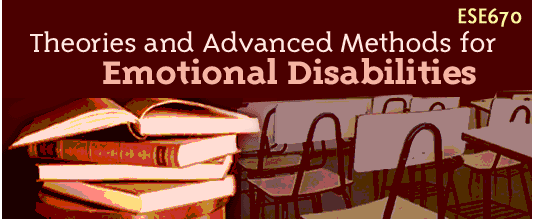Module Four
Reading Two – Overview of the DSM-IV
Reading Two – Overview of the DSM-IV
Review and consider some of these questions and be prepared to discuss them as part of activity two.
Overview of the DSM-IV Process
- Become familiar with the role of diagnosis in the schools.
- Become aware of the uses of the DSM-IV
- Become familiar with the types of information in the DSM-IV
- Be aware of the DSM IV diagnostic model and how it supports diagnosis
- Understand the concept of a multi-axial evaluation
- Learn the importance of the GAF Scale
- Learn what a typical diagnosis and treatment sequence is and when it might be used in schools.
- Recognize how a mental disorder is defined and the value of a decision tree.
Blending the DSM-IV with the IEP process
Questions about utilization:
- How does the DSM-IV diagnostic process contribute to work with youth in the school and in the classroom?
- Who is likely to make the official diagnosis?
- What part of the child study team process might include the teacher or special education personnel reviewing and thinking about decision trees?
- Would it help for a teacher to know about the decision tree and GAF scale during the observation and pre-referral process?
- How might this process of diagnostics contribute to individualized instruction?
- Could the DSM-IV help with a case study and determination of an appropriate set of objectives to help the youngster make wholistic progress – reach social, functional, emotional, intellectual and individual milestones?
Ethics of the process:
- Is it ethical for a teacher to determine a diagnosis and then begin to use it without an official psychological evaluation process?
- If a medical doctor provides a prescription for a student for depression or anxiety, does that constitute an accurate diagnostic procedure? Is it ok at that point to begin saying the child has a specific classification? Would you then classify the child as EBD and place them in special education?
- Can you explain to peers in the child’s class that s/he has a diagnosis and speak openly about the medications and treatment involved?
- Who should know about the DSM-IV and have access to the material in the schools?
Vocabulary that contributes to understanding theDSM-IV:
Diagnosis Symptom Identification
Treatment Planning Prognosis
Mental Disorder Impairment
Prevalence Course of the disease
Familial Pattern Differential Diagnosis
Symptoms Cognitive processes
Mood Behavior
Physical Appearance Multi-axial Evaluation
Clinical Disorders Psychological Disorders
GAF Scale Principal Diagnosis
Mental Status Examination Brief Mental Status Examination
Onset Premorbid Phase
Prodromal Phase Acute Phase
Residual/Chronic Phase Remission Phase
NOS V Codes
Mental Retardation Learning Disorders
Motor Skills Disorders Communication Disorders
Pervasive Developmental Disorders Tic Disorders
Attention-Deficit & Disruptive Behavior Elimination Disorders
Feeding and Eating Disorders Separation Anxiety
Selective Mutism Reactive Attachment Disorder
Stereotypic Movement Disorder Personality Disorder
Axis I Axis II Axis III Axis IV Axis V
Go to Activity Two

